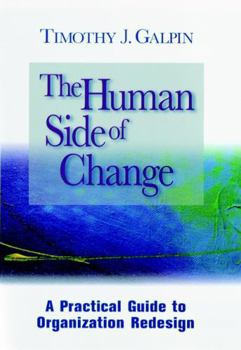The Human Side of Change: A Practical Guide to Organization Redesign
Select Format
Select Condition 
Book Overview
Even the most carefully planned organizational changes can fail if individuals are not taken into consideration. The Human Side of Change is a step-by-step action plan for the change process that takes full advantage of an organization's greatest resource: its people. From planning to implementation to behavior change, Timothy J. Galpin shows how a well-orchestrated approach--one that pays attention to the soft side aspects of the process--can make the difference between change for the better and no change at all. Drawing on a decade of consulting experience with businesses and governments around the world, Timothy J. Galpin outlines a nine-step process for effectively combining the human and technical sides of change for successful mergers, downsizing, and restructuring. The Human Side of Change offers managers, frontline supervisors and human resource professionals valuable tools, techniques, and examples to help them gain support for change at all levels of an organization. With numerous charts, graphs, and a glossary of change-management terms, this book is both an ideal blueprint and an accessible quick reference for the implementation of stable and sustained transformation.
Format:Hardcover
Language:English
ISBN:0787902160
ISBN13:9780787902162
Release Date:April 1996
Publisher:Jossey-Bass
Length:176 Pages
Weight:0.80 lbs.
Dimensions:0.7" x 9.1" x 6.2"
Customer Reviews
1 rating
Pithy, Practical Guide to Mapping Change
Published by Thriftbooks.com User , 24 years ago
This book is short and to the point. Proceding from the perception of a need to change, it directs the reader through myriads of questions and processes to be able to direct an organization through change.Galpin points out repeatedly that change is a process that takes a period of time to institute. The model of change proposed is a nine spoked wheel outlining clearly the organizational steps required to proceed through the process. Appendix A and B are lists of questions that need to be addressed in this steps of the change process.Most useful are the eight topics relevant to change. There is a chapter devoted to each topic. The topics are teams, communications, culture, leadership, goal setting, performance measurement, coaching and rewards.One of the most important concepts in this book is related to the idea that change cannot occur without changing the culture of the organization. Ten areas of organizational culture are identified. The change agent is encouraged to analyze each area of the culture and change all possible relevant aspects of the culture in order to support the proposed change.Communication is also stressed. In order to involve all the organizational players, there needs to be communication to and from each person. Ongoing methods of distribution of information and acquiring feedback need to be implemented. It is not enough to passively submit to listening to feedback. Specific feedback needs to be sought. This reviewer appreciated the pithy, pointed format of this book. Other individuals who have also read this book, told this reviewer that they think this book should be required reading for the healthcare industry. However, the book invites further discovery in the topic of change.





